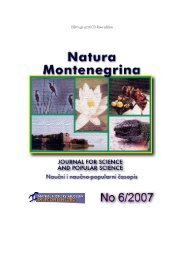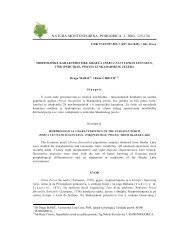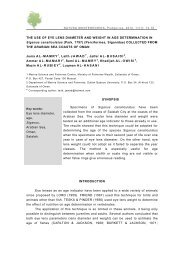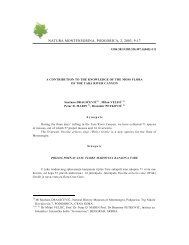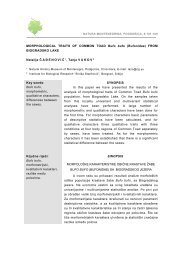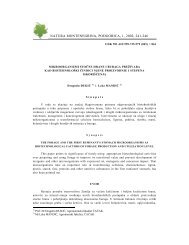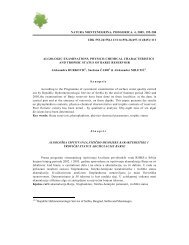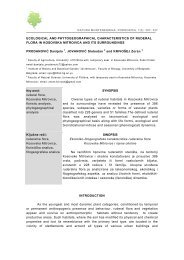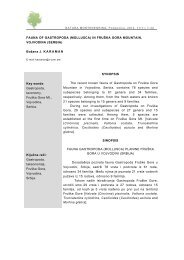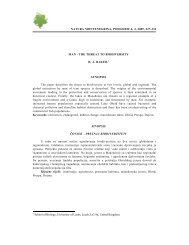111 three water mite species of the genus torrenticola
111 three water mite species of the genus torrenticola
111 three water mite species of the genus torrenticola
You also want an ePaper? Increase the reach of your titles
YUMPU automatically turns print PDFs into web optimized ePapers that Google loves.
NATURA MONTENEGRINA, PODGORICA, 3, 2004, 37-41<br />
UDK 591.9:595.42(560)(045)=<strong>111</strong><br />
THREE WATER MITE SPECIES OF THE GENUS TORRENTICOLA PIERSIG (ACARI,<br />
HYDRACHNIDIA) NEW FOR THE TURKISH FAUNA<br />
Davut TURAN 1 & Vladimir PESIC 2<br />
S y n o p s i s<br />
Water <strong>mite</strong> specimens were collected from Iyidere (Ikiz) in period April and May 2004. In<br />
this study, <strong>three</strong> <strong>water</strong> <strong>mite</strong> <strong>species</strong> <strong>of</strong> <strong>the</strong> <strong>genus</strong> Torrenticola Piersig (Acari: Hydrachnidia,<br />
Torrenticolidae): T. anomala (Koch, 1837), T. brevirostris (Halbert, 1911) and T. barsica<br />
(Szalay, 1933), are reported for <strong>the</strong> first time from Turkey.<br />
Keywords: Acari, <strong>water</strong> <strong>mite</strong>s, Turkey, Torrenticola, new records.<br />
S y n o p s i s<br />
TRI VRSTE VODENIH GRINJA IZ RODA TORRENTICOLA PIERSIG (ACARI,<br />
HYDRACHNIDIA) NOVE ZA FAUNU TURSKE<br />
Vodene grinje sakupljene su u potoka Iyidere (Ikiz) u aprilu i maju 2004. Tokom ove<br />
studije, prvi put su u fauni Turske registrovane tri vrste vodenih grinja iz roda Torrenticola<br />
Piersig (Acari: Hydrachnidia, Torrenticolidae): T. anomala (Koch, 1837), T. brevirostris (Halbert,<br />
1911) i T. barsica (Szalay, 1933).<br />
Ključne riječi: Acari, vodene grinje, Turska, Torrenticola, novi nalazi.<br />
1 K.T.Ü. Rize Su Ürünleri Fakültesi, Fener Mahalesi, 53100, Rize, Turkey<br />
2 Department <strong>of</strong> Biology, University <strong>of</strong> Montenegro, Cetinjski put b.b., 81000 Podgorica, Montenegro,<br />
Serbia and Montenegro (email: pesicv@cg.yu)
38<br />
Natura Montenegrina, 3/2004<br />
INTRODUCTION<br />
Water <strong>mite</strong>s <strong>of</strong> <strong>the</strong> <strong>genus</strong> Torrenticola Piersig have been found in all biogeographic<br />
regions except for Australia and Antarctica (W i l e s, 1997). The aim <strong>of</strong> this paper is to<br />
contribute elements for an extended revision <strong>of</strong> <strong>the</strong> diversity, distribution and ecology <strong>of</strong><br />
torrenticolid <strong>water</strong> <strong>mite</strong>s in <strong>the</strong> river basins draining Eastern Turkey.<br />
At present, only <strong>three</strong> <strong>species</strong> <strong>of</strong> <strong>the</strong> <strong>genus</strong> Torrenticola Piersig are known from Turkey<br />
(S m i t, 1995; Ö z k a n, 1982; T u r a n, 1997): Torrenticola elliptica (Maglio, 1909), T. ungeri<br />
(Szalay, 1927) and T. amplexa (Koenike, 1908).<br />
During a survey <strong>of</strong> <strong>the</strong> fresh<strong>water</strong> fauna <strong>of</strong> Eastern Black Sea coast (Fig. 1), several<br />
<strong>species</strong> <strong>of</strong> <strong>the</strong> <strong>water</strong> <strong>mite</strong> were collected, including <strong>the</strong> <strong>three</strong> <strong>species</strong> <strong>of</strong> <strong>the</strong> <strong>genus</strong> Torrenticola<br />
Piersig, new for <strong>the</strong> Turkish fauna.<br />
Fig 1. A map <strong>of</strong> <strong>the</strong> study area (Eastern Black Sae coast – Turkey)<br />
MATERIAL AND METHODS<br />
Water <strong>mite</strong>s were collected by hand netting, sorted on <strong>the</strong> spot from <strong>the</strong> living material,<br />
and conserved in Koenike’s fluid and dissected as described elsewhere (e.g. G e- r e c k e, 1991).<br />
Slide-mounted specimens and material preserved in fluid is lodged in <strong>the</strong> collection <strong>of</strong> <strong>the</strong> second<br />
author, fur<strong>the</strong>r material will be deposited in <strong>the</strong> collection <strong>of</strong> <strong>the</strong> first author.
39<br />
PEŠIĆ, V., TURAN, D: Three <strong>water</strong> <strong>mite</strong> <strong>species</strong> new for <strong>the</strong> Turkish fauna<br />
The following abbreviations are used: I-L-6 = Leg 1, sixth segment, P-1 = palp, first<br />
segment, Cx-1 = first coxae, L = length, W = width, H = height, n = number <strong>of</strong> specimens<br />
examined. All measurements are given in µm.<br />
Genus Torrenticola Piersig, 1896<br />
Sub<strong>genus</strong> Torrenticola Piersig, 1896<br />
Torrenticola anomala (Koch, 1837)<br />
RESULTS<br />
Material examined: Turkey: Eastern Black Sae coast, Iyidere (Ikiz) stream, 16.03.2004, leg.<br />
Turan, 1 male (damaged, gnathosoma and palps lacking), 5 females.<br />
Distribution: Holarctic.<br />
Description: Female: Idiosoma L 750, W 607, dorsal shield L 650, W 514, L/W ratio<br />
1.26; shoulder platelet L 188; frontal platelet L 133; shoulder/frontal platelet L ratio 1.41;<br />
gnathosomal bay L 126, Cx-1 total L 254, medial L 129, Cx-2+3 L 67; ratio Cx-1 total L/Cx-2+3<br />
medial L 1.97, Cx-1 medial L/Cx-2+3 medial L 1.93; genital field 167 in length, 142 in width,<br />
L/W ratio 1.18; distance genital field–excretory pore 184, genital field–caudal body margin 278;<br />
gnathosoma ventral L 308, with flattened ventral margin and long rostrum; chelicera L 347; palp<br />
total L 341, dorsal length and relative length (in paren<strong>the</strong>ses % <strong>of</strong> total length) <strong>of</strong> palp segments:<br />
P-1 33 (9.7), P-2 101 (29.6), P-3 72 (21.1), P-4 <strong>111</strong> (32.6), P-5 24 (7.0); P-2/P-4 ratio 0.91.<br />
Remarks: T. anomala can be recognized in both sexes by <strong>the</strong> gnathosoma with flattened<br />
ventral margin and long rostrum; males are characterized by a series <strong>of</strong> long hairs at <strong>the</strong> posterior<br />
margin <strong>of</strong> <strong>the</strong> genital field and <strong>the</strong> ejaculatory complex with reduced proximal horns (G e r e c k e<br />
& D i S a b a t i n o, 1996).<br />
The dimensions given above fit well with <strong>the</strong> diagnostic character combinations and<br />
variability ranges given for <strong>the</strong> females <strong>of</strong> T. anomala by C i c o l a n i & D i S a b a t i n o<br />
(1990).<br />
Habitat: T. anomala lives in brooks and rivers with sand and gravel substratum; in <strong>the</strong><br />
Iyidegere stream <strong>the</strong> <strong>species</strong> was accompanied by o<strong>the</strong>r <strong>mite</strong>s regularly found in running <strong>water</strong>s as<br />
Sperchon clupeifer, S. hispidus, Sperchonopsis verrucosa, Torrenticola brevirostris, T. barsica,<br />
Lebertia porosa, and Hygrobates fluviatilis.<br />
Torrenticola brevirostris (Halbert, 1911)<br />
Material examined: Turkey: Eastern Black Sae coast, Iyidere (Ikiz) stream, 16 March 2004, leg.<br />
Turan, 12 males, 6 females.<br />
Distribution: Palaearctic.
40<br />
Natura Montenegrina, 3/2004<br />
Description: Male: Idiosoma L 807, W 636, dorsal shield L 679, W 507, L/W ratio 1.34;<br />
shoulder plate L 188; frontal plate L 150; shoulder/frontal plate L ratio; gnathosomal bay L 133,<br />
Cx-1 total L 305, medial L 172, Cx-2+3 L 112; ratio Cx-1 L/Cx-2+3 medial L 1.77 Cx-1 medial<br />
L/Cx-2+3 medial L 1.54; genital field subrectangular in shape, 192 in length, 144 in width, L/W<br />
ratio 1.33; ejaculatory complex L 296; distance genital field–excretory pore 158, genital field–<br />
caudal body margin 203; gnathosoma ventral L 294, with relatively short rostrum and weakly<br />
curved ventral margin; chelicera L 342; palp total L 345-353 (n=2); dorsal length (n=2) and<br />
relative length (n=2, in paren<strong>the</strong>ses % <strong>of</strong> total length) <strong>of</strong> palp segments: P-1 33-34 (9.6), P-2 100-<br />
106 (29.0-30.0), P-3 72-73 (20.7-20.9), P-4 107-<strong>111</strong> (31.0-31.4), P-5 29-32 (8.2-9.3); P-2/P-4<br />
ratio 0.93-0.95; Palp robust, P-1 short, ventral protuberances <strong>of</strong> P-4 ending in two tips separated<br />
by a concavity.<br />
Remarks: T. brevirostris can be recognized in both sexes by <strong>the</strong> gnathosoma with<br />
relatively short rostrum, <strong>the</strong> elongated postgenital area and <strong>the</strong> P-4 relatively longer, P-2/P-4 L <<br />
1.0; males are characterized by <strong>the</strong> excretory pore shifted from <strong>the</strong> line <strong>of</strong> primary sclerotization.<br />
Females (in brackets data from C i c o l a n i & D i S a b a t i n o, 1990) can be distinguished<br />
fur<strong>the</strong>rmore by <strong>the</strong> relatively shorter medial suture line <strong>of</strong> Cx-2+3 (L ratio Cx-2+3/Cx-1 6.2).<br />
The dimensions given above fit well with <strong>the</strong> diagnostic character combinations and<br />
variability ranges given for T. brevirostris by C i c o l a n i & D i S a b a t i n o (1990).<br />
Habitat: T. brevirostris lives in brooks and rivers with sand and gravel substratum, also<br />
in <strong>the</strong> sections with full exposure to sunlight (D i S a b a t i n o et al. 1992).<br />
Torrenticola barsica (Szalay, 1933)<br />
Material examined: Turkey: Eastern Black Sae coast, Iyidere (Ikiz) stream, 16 March 2004, leg.<br />
Turan, 2 males.<br />
Distribution: Europe, Mediterranean, Turkey.<br />
Description: Male: Idiosoma L 693, W 550, dorsal shield L 571, W 443, L/W ratio 1.29;<br />
shoulder platelet L 197; frontal platelet L 131; shoulder/frontal platelet L ratio 1.5; gnathosomal<br />
bay L 150, Cx-1 total L 291, medial L 141, Cx-2+3 L 103; ratio Cx-1 total L/Cx-2+3 medial L<br />
2.06, Cx-1 medial L/Cx-2+3 medial L 1.37; genital field 161 in length, 136 in width, L/W ratio<br />
1.18; ejaculatory complex L 231; distance genital field–excretory pore 82, genital field–caudal<br />
body margin 138; gnathosoma ventral L 311; chelicera L 344; palp total L 310, dorsal length<br />
and relative length (in paren<strong>the</strong>ses % <strong>of</strong> total length) <strong>of</strong> palp segments: P-1 36 (11.6), P-2 99<br />
(31.9), P-3 61 (19.7), P-4 95 (30.6), P-5 19 (6.1); P-2/P-4 ratio 1.04; ventral protuberances <strong>of</strong> P-4<br />
forming an unique tip.<br />
Remarks: The discovery <strong>of</strong> frequent misidentifications <strong>of</strong> this <strong>species</strong> in older<br />
collections confirms that T. barsica for a long time has been poorly understood <strong>species</strong>, and<br />
consequently older records should be accepted with caution. Its distribution area possibly extends<br />
also to Iran (P e s i c et al. unpubl.), Central Europe and South Africa (D i S a b a- t i n o et al.<br />
2003). The dimensions given above fit well with <strong>the</strong> diagnostic character combinations and<br />
variability ranges given for T. barsica by C i c o l a n i & D i S a b a t i- n o (1990).
41<br />
PEŠIĆ, V., TURAN, D: Three <strong>water</strong> <strong>mite</strong> <strong>species</strong> new for <strong>the</strong> Turkish fauna<br />
Habitat: Running <strong>water</strong>s; <strong>the</strong> ecological requirements <strong>of</strong> <strong>the</strong> <strong>species</strong> are <strong>the</strong> similar as for<br />
T. brevirostris with which it was frequently associated.<br />
REFERENCES<br />
C i c o l a n i, B. & D i S a b a t i n o, A (1990). Recherches faunistiques et ecologiques sur les<br />
Hydracariens de l’ Apennin (Italie). La genre Torrenticola Piersig (Acari, Actinedida,<br />
Torrenticolidae). Annls. Limnol. 26 (2-3): 153-176.<br />
D i S a b a t i n o A., G e r e c k e, R., & B. C i c o l a n i (1992). The Water Mites <strong>of</strong> <strong>the</strong> Family<br />
Torrenticolidae Piersig, 1902 (Acari, Actinedida) in Springs and Running Waters <strong>of</strong> Sicily<br />
(Soutrh Italy). Arch. Hydrobiol. Suppl. 90 (2): 253-282.<br />
D i S a b a t i n o, A., G e r e c k e, R., S m i t, H., P e s i c, V., & P a n e s a r, A. (2003).<br />
Water): Mites <strong>of</strong> <strong>the</strong> Family Torrenticolidae (Acari, Actinedida, Hydrachnidia) from <strong>the</strong><br />
Eastern Mediterranean Region. Archiv für Hydrobiologie Suppl., 139 (3): 1-39.<br />
G e r e c k e, R. (1991). Taxonomische, faunistische und ökologische Untersuchungen an<br />
Wassermilben (Acari, Actinedida) aus Sizilien unter Berücksichtigung anderer aquatischer<br />
Invertebraten. Lauterbornia, 7: 1-304.<br />
G e r e c k e, R & D i S a b a t i n o, A. (1996). The Water Mites <strong>of</strong> <strong>the</strong> Family Torrenticolidae<br />
Piersig, 1902 (Acari, Actinedida, Hydrachnellae) in Springs and Running Waters <strong>of</strong><br />
Sardinia and Corsica. Arch. Hydrobiol. Suppl. 107 (3): 287-334<br />
Ö z k a n, M. (1982). Wassermilben (Acari, Actinedida) aus der Türkei. Entomol. Basil., 7: 29-60.<br />
S m i t, H. (1995). New Records <strong>of</strong> Water Mites from Turkey, with 11 Species New for <strong>the</strong><br />
Turkish Fauna (Acari: Hydrachnellae). Storkia, 4: 10-15.<br />
T u r a n, (1997). Değermendere Su Akarlarının Ekolojik ve Sistematik Yönden İncelenmesi,<br />
K.T.Ü. Fen Bilimleri Enstitüsü, Yüksek Lisans Tezi, 48 pp.<br />
W i l e s, P. R. (1997). Asian and Oriental Torrenticolidae Piersig, 1902 (Acari: Hydrachnidia:<br />
Lebertioidea): A Revision <strong>of</strong> <strong>the</strong> Family and Description <strong>of</strong> New Species <strong>of</strong> Torrenticola<br />
Piersig and Pseudo<strong>torrenticola</strong> Walter, from Sou<strong>the</strong>ast Asia. Journal <strong>of</strong> Natural History,<br />
31: 191-236.
42<br />
Natura Montenegrina, 3/2004



